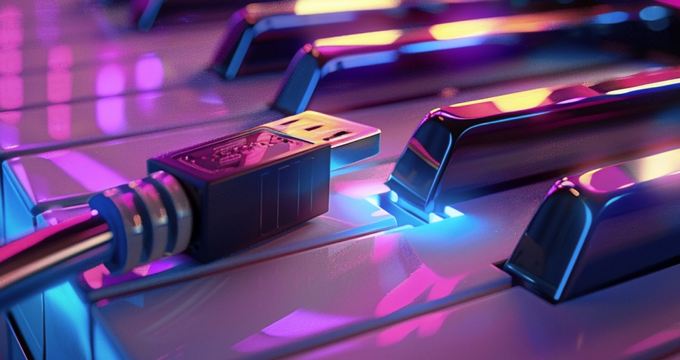
Before using Misolla, you need to connect your musical instrument to your device (laptop, tablet, phone, etc.). To determine the right cable, you need to know which type of connector is used in your musical instrument.
Which connector is used in your instrument: USB Type B or MIDI
In today's world of music and technology, there are multiple ways to connect musical equipment to computers and other devices. Two of the most common options are via USB Type B connector and MIDI IN/OUT ports. Let's explore the features of each and how to determine which connector your instrument uses!
USB type B
The USB Type B connector is distinguished by its square shape with a protruding edge, setting it apart from other USB connectors.
If you are unsure whether your musical instrument has a USB Type B connector, you can usually find this connector on the back or side of the instrument. It may be labeled "USB" or have a symbol that looks like the USB logo.

MIDI IN/OUT Ports
MIDI IN/OUT ports are another method of connecting musical instruments. MIDI is a communication standard for transmitting musical data between devices. These ports are typically presented as a pair: IN (input) and OUT (output).
To determine if your musical instrument has MIDI IN/OUT ports, look for connections near audio outputs or USB ports labeled "MIDI" or "MIDI IN" and "MIDI OUT".

Connecting to a PC or Mac
Before choosing a cable, check what type of USB connector is available on your PC or MacBook. Usually, a computer will have one of two connector types:
- USB Type C: smaller and newer connector
- USB Type A: standard-sized connector
MIDI Connection to a PC
You will need a MIDI to USB-A cable.

If needed, purchase a USB-A to USB-C adapter (if the port on your computer is USB Type C).

*Attention! We have identified a low-quality cable. If you are experiencing issues with MIDI and your cable looks like the one pictured below, the problem is likely with the cable itself. *

Connection via USB to a PC
You will need the following cable:
- USB-B to USB-A or
- USB-B to USB-C (depending on the port on your computer)
!!! Perhaps you already have a USB-B to USB-A cable; such a cable typically comes with a piano or printer.


Connection to Android
Before selecting a cable, check which type of USB connector is available on your Android device. Typically, phones and tablets have one of two types of connectors:
- USB Type C: newer connector
- USB Micro: connector in older models
MIDI Connection for Android
Purchase a MIDI to USB-A cable.

Purchase an adapter corresponding to your port:
- USB-A to USB-C or
- USB-A to USB Micro


If you're experiencing problems and your cable resembles the one shown below, the issue is likely due to the cable.

Connection via USB for Android
There are two options:
- Purchase a cable based on your port:
- USB type B to USB type C or
- USB type B to USB Micro


- If you already have a USB-B to USB-A cable (usually included with pianos or printers), then you need an adapter corresponding to your port:
- USB-A to USB-C or
- USB-A to USB Micro


Connection to iPad, iPhone
Compatibility for iPad and iPhone is in progress.
As of now, you can use the application on PC, Mac, or Android devices.